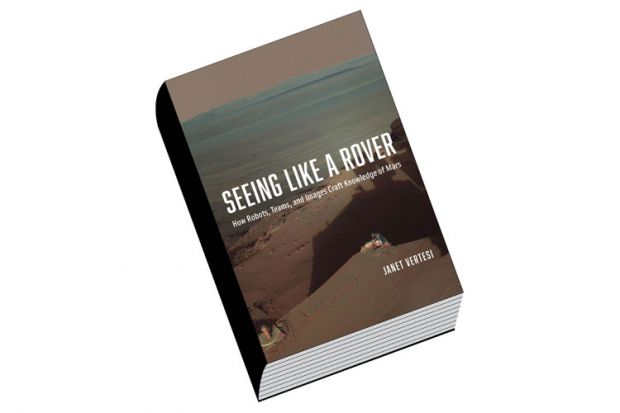I admit I was a bit nonplussed when I began reading this book. I thought that I had agreed to review a book about the surface of Mars and what has been learned from the striking images acquired by the several rovers and orbiters that have visited the red planet since 2003. Instead, I had something much more interesting: an account by an ethnographer, Janet Vertesi, of the two years she spent “embedded” within Nasa’s Mars Exploration Rover teams.
Vertesi’s book offers fascinating insights into the work that goes on behind the camera, in terms not only of the production of an image, but also of the entire process that surrounds it, from how decisions about which image to take are made, to the calibration of images, colouring, etc. She describes interactions between team members, particularly the differing emphasis placed on images by scientists (who wish to understand Mars) and engineers (who don’t want to place the rovers at risk). The balance between risk and investigation was one that had to be adjusted every day, and the fragments that Vertesi offers of conversations during daily Science Operations Working Group team meetings illustrates the constant trade-off and negotiations necessary to ensure the success of the rover traverses.
Although the text is naturally illustrated with many images of the surface of Mars, there are almost as many pictures of computer screens showing software and how combinations of images and application of different filters can enhance specific aspects of a scene. One example is given of a single image, processed in two different ways. The first brings out the texture of the rocks to allow geologists to infer stratigraphy, while the second highlights the different colours of the surface to enable interpretation of rock and soil compositions. Part of the book’s fascination lies in how Vertesi interprets the images in terms of “evolving conversations”. She looks at how an image becomes coloured, annotated and overlain by graphics. Each iteration, she says, “captures a consensus moment in the evolving story of the mission”. Reinterpreting the phrase “a picture is worth a thousand words”, Vertesi observes that since pictures “must be planned, negotiated, annotated, discussed, transformed and spoken for, we might say that thousands of words go into crafting them”.
Why is it useful to have an ethnographer observing the work of a space mission team? Simply put, it provides a different perspective on the work being carried out. When you are deeply engrossed in a project, you can be in danger of losing sight of the bigger picture. Having an external viewpoint from a neutral observer can be beneficial. We are reminded of this in a chapter that covers the processes required to calibrate raw images of the Martian landscape so that they can be interpreted by the science and engineering teams. Vertesi saw that many of the personnel undertaking the calibration were students who, although they had been given detailed training in how to undertake the calibration, did not know what they were doing in terms of understanding the algorithms they were applying. As she relates, when scientists in charge of this aspect of the work read her draft chapter on this part of the project, it prompted them to revisit their training, and offer a mini-workshop to explain the data calibration process in greater detail.
I was amused by the references Vertesi makes to her “field notes” and fieldwork. Nevertheless, the terms are as apt as they are ironic: as an ethnographer, she was undertaking in situ fieldwork on a group of scientists and engineers who were undertaking fieldwork remotely – very remotely. One tiny gripe: there are abundant notes to each chapter, but they appear as endnotes. While they are generally useful, I would have found them even more accessible if they had appeared at the end of each chapter. All in all, however, Seeing Like a Rover proved to be a most entertaining read, once I got past some of the more discipline-specific ethnographic terms. I suspect, however, that my learning curve was much less steep than the author’s – after all, she had to get to grips with the acronym-laden vocabulary of a space mission!
Monica Grady is professor of planetary and space sciences, the Open University.
Seeing Like a Rover: How Robots, Teams and Images Craft Knowledge of Mars
By Janet Vertesi
University of Chicago Press, 304pp, £24.50
ISBN 9780226155968 and 56019 (e-book)
Published 25 May 2015
POSTSCRIPT:
Print headline: Left a bit...right a bit...perfect
Register to continue
Why register?
- Registration is free and only takes a moment
- Once registered, you can read 3 articles a month
- Sign up for our newsletter
Subscribe
Or subscribe for unlimited access to:
- Unlimited access to news, views, insights & reviews
- Digital editions
- Digital access to THE’s university and college rankings analysis
Already registered or a current subscriber? Login
